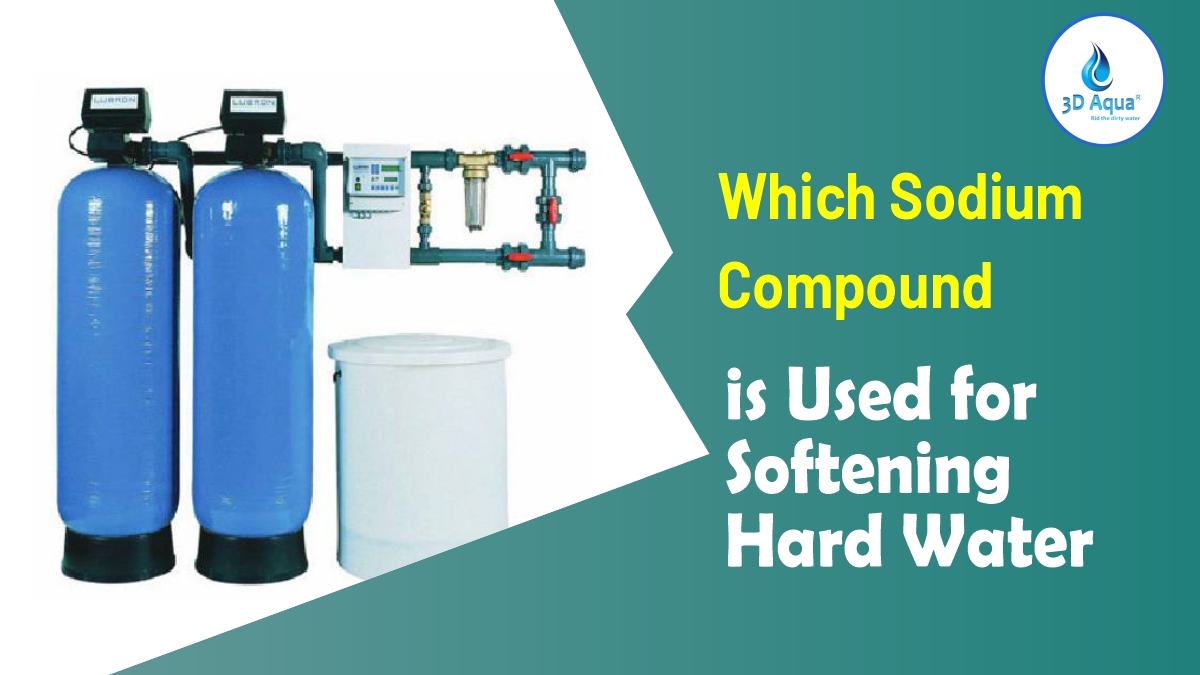Hard water is a common problem faced by households and industries across the world, including India. It is characterized by high levels of calcium (Ca²⁺) and magnesium (Mg²⁺) ions. While hard water is not harmful to human health, it can cause various practical problems. These include the scaling of pipes, appliances like dishwashers and washing machines, and boilers, leading to inefficiency and increased energy consumption. Furthermore, hard water can make soap and detergents less effective, leading to higher usage.
One of the most effective methods to combat these issues is the use of water softeners. A water softener is a device that removes calcium and magnesium ions from hard water and replaces them with sodium ions. This process, known as ion exchange, is widely used to soften water. In this article, we will explore which sodium compound is used for softening hard water and examine whether water softeners reduce the total dissolved solids (TDS) in water.
The Science Behind Water Softening
Water softening is primarily achieved through a process called ion exchange. In this process, calcium and magnesium ions present in hard water are exchanged with sodium ions. The ions are charged particles, and because both calcium and magnesium are positively charged (cations), they can be replaced by sodium ions in a system that uses a resin bed.
The resin used in water softeners contains small beads that are coated with sodium ions. As hard water flows through the resin, the calcium and magnesium ions in the water are attracted to the resin beads, and the sodium ions are released in exchange. This effectively “softens” the water, as it now contains sodium instead of calcium or magnesium ions.
Sodium Compounds Used in Water Softening
The primary sodium compound used for softening hard water is sodium chloride (NaCl), commonly known as table salt. Here’s how sodium chloride plays a key role in the softening process:
1. Sodium Chloride (NaCl) – Common Salt
Sodium chloride is the most common and widely used compound in water softening systems. When the resin beads in a water softener become saturated with calcium and magnesium ions, they need to be regenerated. Regeneration is the process of replacing the calcium and magnesium ions on the resin with sodium ions.
To achieve this, a concentrated solution of sodium chloride is flushed through the resin. The sodium ions from the salt solution replace the calcium and magnesium ions on the resin beads. This process allows the resin to continue softening water effectively. The regeneration cycle typically happens automatically and takes place every few days or after the water softener has processed a certain amount of water.
- How Sodium Chloride Works in Water Softening:
- Sodium chloride is dissolved in water to create a brine solution.
- The brine solution is passed through the resin bed, where sodium ions replace the calcium and magnesium ions.
- The calcium and magnesium ions are flushed out, and the resin bed is ready to soften water again.
Advantages of Sodium Chloride in Softening:
- Widely Available: Sodium chloride is inexpensive and readily available, making it the most cost-effective option for water softening.
- Efficient Regeneration: Sodium chloride provides an efficient and quick regeneration cycle, ensuring that water softeners operate at peak performance.
2. Sodium Carbonate (Na₂CO₃) – Soda Ash
While sodium chloride is the most commonly used sodium compound in water softening, sodium carbonate (also known as soda ash) is sometimes used in certain types of water softening systems. Sodium carbonate is often used in combination with sodium chloride for specific applications, particularly when the water contains high levels of calcium and magnesium, or when a higher level of softening is required.
Soda ash can also aid in water softening by adjusting the pH of the water, making it more conducive for the ion exchange process. It works by binding with calcium and magnesium to form insoluble compounds, which can then be removed more easily through filtration or precipitation.
- How Sodium Carbonate Works:
- Sodium carbonate is added to water to help precipitate out the calcium and magnesium ions.
- The compound helps in the formation of insoluble salts of calcium and magnesium, which can be easily removed.
Advantages of Sodium Carbonate in Softening:
- pH Adjustment: It can help control the pH of the water, ensuring that the water softening process occurs smoothly.
- Effective for High Hardness: When water hardness is particularly high, soda ash can enhance the softening process.
3. Sodium Hydroxide (NaOH) – Caustic Soda
Sodium hydroxide, or caustic soda, is another sodium compound that may be used in specific water treatment processes, particularly in industrial water softening applications. While not as common as sodium chloride, caustic soda is sometimes used in combination with other chemicals to remove hardness ions from water.
Sodium hydroxide is typically used in a process known as lime soda softening. In this method, sodium hydroxide is used in combination with calcium hydroxide (lime) to precipitate calcium and magnesium from water. The result is soft water that is free of these hardness-causing minerals.
- How Sodium Hydroxide Works:
- Sodium hydroxide is added to water in combination with lime.
- The reaction between sodium hydroxide and calcium or magnesium ions causes them to precipitate out as insoluble compounds, leaving the water soft.
Advantages of Sodium Hydroxide in Softening:
- Effective for Industrial Applications: Caustic soda is effective in large-scale industrial water softening processes where very hard water is involved.
- Cost-Effective for Large Volumes: It can be an economical solution for large water volumes requiring softening.
Does Water Softener Reduce TDS?
One of the common questions that arises when using water softeners is whether they reduce the total dissolved solids (TDS) in water. TDS is a measure of the total concentration of dissolved substances, including minerals, salts, and metals, in water.
Impact of Water Softeners on TDS
Water softeners primarily remove calcium and magnesium ions, replacing them with sodium ions. However, this process does not significantly reduce the overall TDS of the water. Here’s why:
- What Water Softeners Remove: Water softeners focus mainly on removing the hardness-causing minerals, i.e., calcium (Ca²⁺) and magnesium (Mg²⁺). These ions contribute to the hardness of water, but they are only a part of the total dissolved solids. Other dissolved substances such as sodium, chloride, sulfate, bicarbonates, and other minerals will remain unaffected by the softening process.
- The Role of Sodium: While sodium ions replace calcium and magnesium ions, the sodium content in the water increases. This means that although the hardness of the water is reduced, the overall TDS remains largely unchanged, or may even increase slightly, due to the added sodium.
Comparing TDS Levels Before and After Softening
- Before Softening: A sample of hard water will have a high TDS level due to the presence of calcium and magnesium, along with other dissolved solids.
- After Softening: After passing through a water softener, the water will have lower hardness (due to reduced calcium and magnesium ions) but may still have a similar TDS level, with sodium ions now present in place of calcium and magnesium.
Key Takeaways
- Sodium Chloride (NaCl) is the most commonly used sodium compound for softening hard water. It effectively exchanges sodium ions for calcium and magnesium ions, reducing water hardness.
- Sodium Carbonate (Na₂CO₃) and Sodium Hydroxide (NaOH) are used in specific situations, particularly when higher levels of softening or pH adjustment are required.
- Water Softener Effect on TDS: While water softeners significantly reduce water hardness by removing calcium and magnesium, they do not reduce TDS levels to a great extent. The sodium ions replace hardness-causing ions, and other dissolved solids remain present.
Conclusion
In conclusion, sodium chloride (NaCl) is the primary sodium compound used in water softeners to reduce water hardness. It efficiently exchanges sodium ions for hardness-causing calcium and magnesium ions. While water softeners are excellent at reducing hardness, they do not significantly lower the TDS of water, as they only target specific minerals. Understanding this process can help homeowners and industries make informed decisions about water softening systems based on their water quality and treatment needs.
Whether you’re looking to protect your appliances, reduce soap consumption, or improve your skin and hair, a well-chosen water softener can provide long-term benefits. However, if your goal is to reduce TDS significantly, you may need to explore other water treatment methods like reverse osmosis (RO) or distillation, which can effectively reduce overall TDS levels.
If you are looking for expert assistance in managing scaling and optimizing the performance of your RO plant, 3D Aqua Water Treatment Company, based in Delhi/NCR, offers top-tier solutions for industrial RO plants, commercial RO plants, sewage treatment plants, water softeners, and effluent treatment plants. Our 24×7 customer support ensures you always have the help you need to keep your systems running smoothly. Contact us at +91-8963089630 or email info@3daqua.in for more information and product inquiries.

